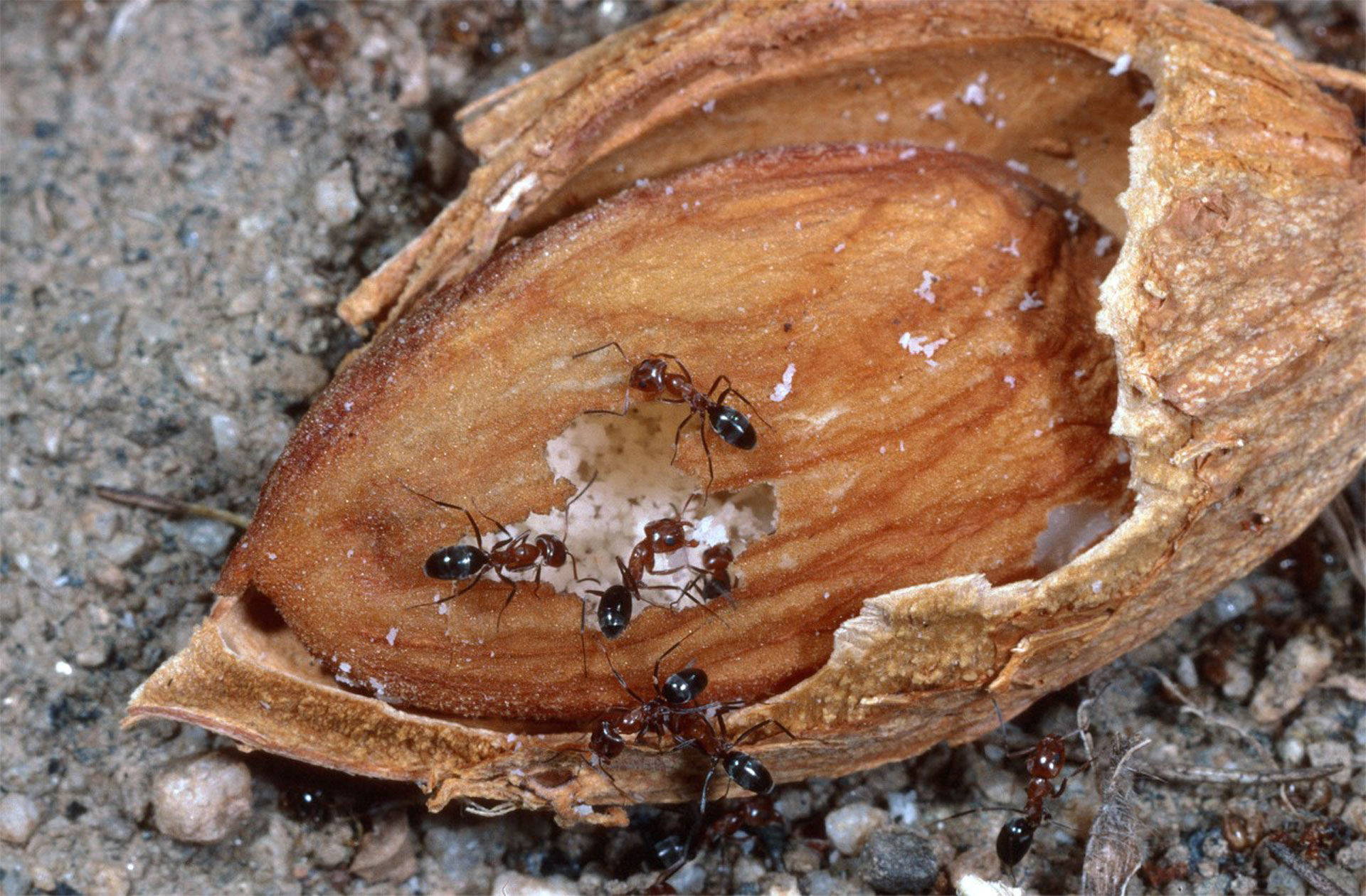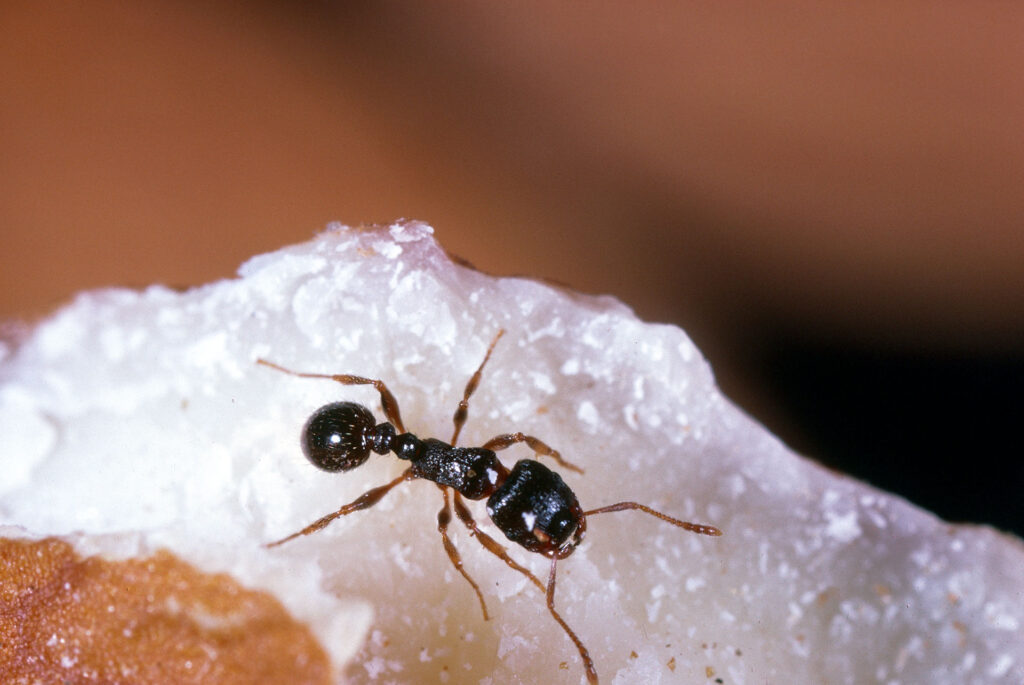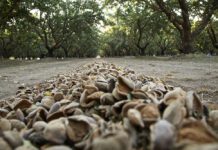
There are two main ant pests in almonds: the pavement ant and the southern fire ant. The pavement ant is about 0.13 inch long, dark brown and covered with coarse hairs. It has ridges on its head that are visible with a hand lens and prefers to nest in sandy or loam soils. It’s found throughout the Central Valley, but most commonly in the northern San Joaquin and Sacramento valleys.
The southern fire ant is 0.07 to 0.25 inch long and has an amber head and thorax with a black abdomen. Compared to pavement ants, fire ants vigorously swarm from the nest entrance when disturbed.
“Both ant species are primarily protein feeders,” according to David Haviland, UCCE entomology and pest management farm advisor for Kern County, and almond kernels are excellent sources of protein. “That’s why we grow them and eat them.
“Different ants respond differently to different climates, different ground covers, different types of soils and different amounts of rainfall,” Haviland said.
Neither species likes to climb trees, but once the nuts are harvested and on the ground, they eat them, especially if there’s an opening in the shell.
Ant Management
“The amount of ant damage sustained is directly proportional to how long the nuts are sitting on the ground,” Haviland said, so the biggest factor in ant management is manipulating how long the nuts are on the ground.
“Once the nuts are shaken, of course they need to dry, they need to be blown, windrowed and then picked up. And the issue is, from an ant management standpoint, the longer the nuts are on the tree, and the drier they are when you shake the tree, the less time they need on the ground before you can pick them up,” Haviland said.
But the longer the nuts are left in the tree, the longer they are exposed to navel orangeworm. So growers are juggling between harvesting the trees as late as possible to minimize ant damage and getting the nuts off the tree as fast as possible to prevent naval orangeworm damage.
“What ends up happening is growers primarily deal with the ants by applying baits, and then shaking the trees as soon as possible,” Haviland said.
Shell Uniformity
Hard shell varieties are less susceptible to ant damage than soft shell varieties. “All varieties have split hulls, but the integrity of the shells does change,” Haviland said, adding the way the almonds are managed during the year can affect the integrity of the shell.
Haviland explains that if almonds are really wet, then really dry, then really wet, then really dry, there will be periods of rapid hull expansion, and it can impact the uniformity of the shell.
It’s similar to growing backyard tomatoes. “If you forget to water them for a couple of weeks, and then give them tons of water, those tomatoes expand really fast and split. The same can happen with cherries close to harvest if you get a rainstorm,” Haviland said, adding uniform irrigation and growth equals a more uniform shell.
Organic Management
There are organic baits, but they aren’t as effective as conventional baits, Haviland said.
“For organic growers, it really comes down to getting the nuts off the ground as fast as possible. Also, a lot of organic growers, in order to help prevent damage from navel orangeworm, tend to grow more hard shell varieties because they’re less susceptible to navel orangeworm. That also makes those varieties less susceptible to ant damage.”
Determining Damage
Taking annual samples at harvest is important to determine the level of ant damage.
“One way you can tell that it’s ant damage is that the ants don’t like the skin of the kernel. So, if all the white meat part of a kernel is eaten out, and there’s still remnants of the skin from the surface of the kernel, that’s ant damage,” Haviland said, adding they will also leave behind a powdery substance that is an indication of ant damage.
Pros and Cons of Specific Baits
Baits fall into two main groups. Clinch, Esteem, Extinguish are all applied approximately two months before harvest (May and June). The worker ants take the bait into the colony, it’s fed to the queens and the queens become sterile and/or die.
“This has been a standard practice for a couple of decades,” Haviland said.
There is also a newer bait called Altrevin. Altrevin works much faster, but doesn’t have the residual effect of the other baits.
“Growers that want to use Altrevin will typically apply it within a couple of weeks of harvest,” Haviland said.
The advantage of first three baits are that they are inexpensive and applied earlier in the season when typically labor and equipment are available to make those applications.
In comparison, an application of Altrevin must be made just prior to harvest when growers are in harvest preparation and equipment may be tied up with hull split sprays, mowing and other ground preparations.
“There’s just a lot of things going on at that time, where it’s nice to just say in May or June that you’ve checked the box, you’ve put out your baits and ants won’t be a problem,” Haviland said.
But Altrevin has the advantage that growers can monitor ant populations and decide whether or not to treat two weeks before harvest.

“It’s easier to react to the population in the field with a later treatment, whereas most treatments that are done in May and June are done on more of a presence/absence preventative approach, which works and is very effective. But in hindsight, all of those fields may not have needed treatment,” Haviland said.
If growers have the manpower and the ability to make a late application, they could save money using Altrevin because they might not need to make an application, depending on ant populations.
To maintain bait quality and maximize bait pickup by ants:
- Don’t use baits within 24 hours after an irrigation or 48 hours before an irrigation with sprinklers or microsprinklers. The soil surface should be dry so that moisture is not absorbed by the bait and reduce its attractiveness to the ants.
- Use bait products soon after opening and do not store bait for more than a few weeks. Open bags should be used within a week or two so that the soybean oil does not become rancid and be less attractive to ants.
- Purchase only as much bait as can be used in the current season.
Monitoring
Monitoring is always advised, but at the same time, thresholds can be difficult to interpret, Haviland said.
“Imagine if you harvest a field and you get the nuts out within three days, versus harvest the same field, on the same day, but it takes you 10 days to remove the nuts. That’s the difference between ants being a problem or not,” Haviland said.
Treatment isn’t solely dependent on how many ants there are; it’s also dependent on the details of harvest, how much equipment a grower has and how long the nuts are on the ground.
“Sometimes those details aren’t available until real time. In May, you don’t know if it’s going be sunny or whether a cool rainstorm will come in the middle of harvest. That’s not common, but still, you don’t know what the weather is going to be until the week of the weather,” Haviland said, and if yields are higher than expected, it can impact how much time it takes to get the nuts out of the field.
There are ant monitoring guidelines available on the UC IPM website at www2.ipm.ucanr.edu/agriculture/almond/Ants/.















